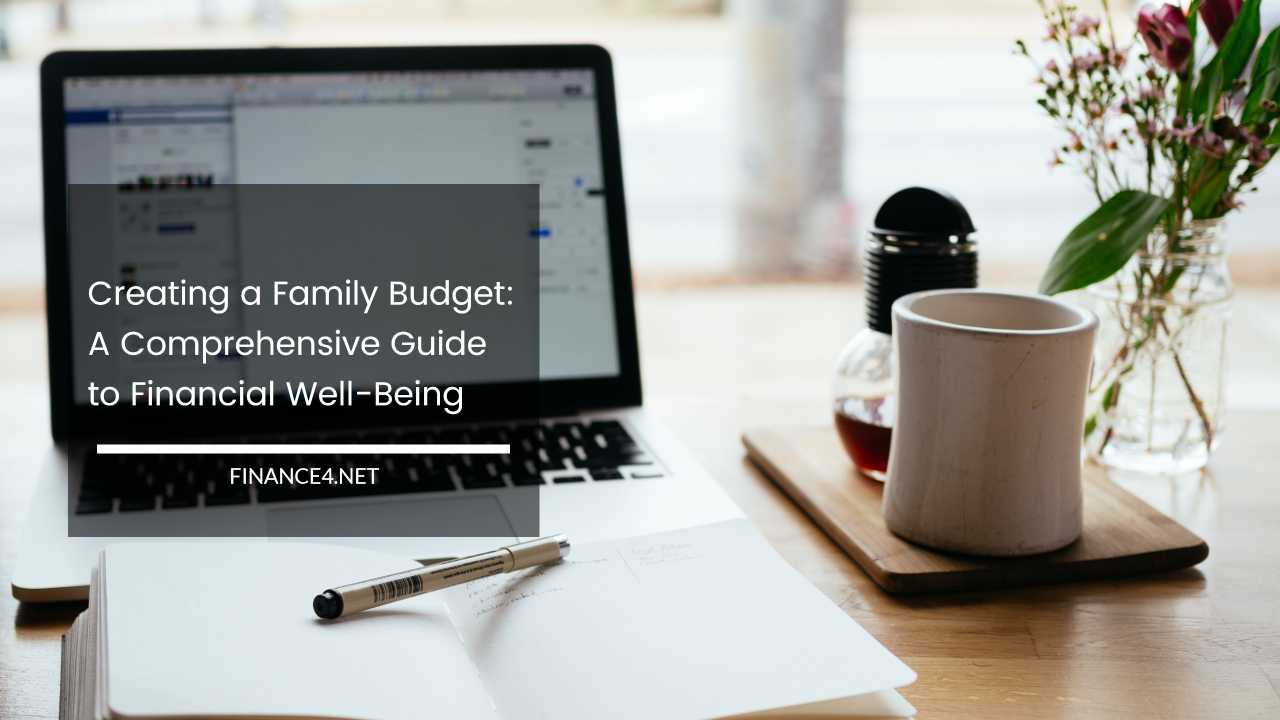Creating a Family Budget: A Comprehensive Guide to Financial Well-Being

Family Budget
The concept of budgeting can be daunting for many, often causing stress and anxiety. The thought of diligently tracking and managing your family’s finances may seem overwhelming, and the fear of making one wrong financial move that could disrupt your entire financial plan can be paralyzing.
However, budgeting is an essential aspect of maintaining financial stability and achieving your family’s financial goals.
In this guide, we will delve into the “No Fret Family Budget,” a systematic approach that can help you navigate the world of budgeting with ease and confidence.
What Is a Budget?
Before we dive into the specifics of the “No Fret Family Budget,” let’s clarify what a budget is and why it’s crucial for managing your finances effectively.
A budget is essentially a financial tool used to control a family’s expenditures in a way that ensures there is enough money to cover essential expenses while also setting aside savings for future financial goals.
These goals could range from funding your children’s education to going on vacations, buying a house, or planning for retirement.
The primary purpose of a budget is to provide you with a clear overview of your financial situation and help you make informed decisions about your spending. It’s a roadmap that guides you toward financial stability and success.
By adhering to a budget, you can eliminate financial stress and pave the way for a secure and prosperous future.
Now, let’s explore the step-by-step approach outlined in the “No Fret Family Budget.”
Step 1: Determine Your Average Monthly Earnings
The first step in creating a family budget is to determine your average monthly earnings. To do this, follow these guidelines:
- Gather three months of your pay stubs: Collect your pay stubs from the past three months. These documents provide a comprehensive record of your income.
- Calculate your average monthly earnings: Add up your total earnings from the three months and divide the sum by three. This will give you a reasonably accurate estimate of your average monthly income.
This initial step lays the foundation for your budget. Understanding your income is crucial because it sets the limit for your spending and savings.
Step 2: Calculate Your Monthly Expenses
Next, you need to determine your monthly expenses. Your expenses can be categorized into two main types: fixed and variable expenses.
- Fixed Expenses: These are recurring costs that stay relatively constant from month to month, such as rent or mortgage payments, utility bills, car payments, and any other loans that require monthly payments.
- Variable Expenses: These expenses can fluctuate from month to month and include items like groceries, entertainment, dining out, and credit card bills.
To calculate your monthly expenses, follow these steps:
- Collect your monthly bills: Gather your bills and statements for the past three months, categorizing them as fixed or variable expenses.
- Calculate the average monthly cost: Add up your fixed expenses and divide the total by three to find the average monthly cost. Do the same for your variable expenses.
Understanding your expenses in this manner gives you a clear picture of where your money is going and helps you prepare for budgeting more effectively.
Step 3: Evaluate Your Financial Situation
With your average monthly earnings and expenses determined, it’s time to evaluate your financial situation. This step involves comparing your income to your expenses and identifying areas where you can economize.
When evaluating your financial situation:
- Compare your average monthly earnings to your average monthly expenses: This comparison will reveal whether you are living within your means or if there’s a gap between your income and expenses.
- Identify areas for economizing: If you find that your expenses are significantly higher than your earnings, consider where you can cut back on spending. Look for items in your variable expenses that are non-essential and can be reduced or eliminated.
The goal here is to balance your budget by ensuring that your income can comfortably cover your essential expenses, leaving room for savings.
Step 4: Create Your Family Budget
Based on the insights gained from steps 1 to 3, you can now create your family budget. A budget is essentially a financial plan that outlines how you will allocate your income across various spending categories. To create your budget:
- List your income: Start by listing your average monthly earnings.
- Categorize your expenses: Create categories for your fixed and variable expenses, listing each expense under the appropriate category.
- Allocate your income: Distribute your income among the various expense categories. Ensure that you allocate enough to cover your fixed expenses and allow for savings.
Your budget serves as a practical guide that helps you make financial decisions. It ensures that you are living within your means and that you are setting aside money for your financial goals.
Step 5: Establish a Savings Account
Once your budget is in place, it’s time to take concrete steps to save for your family’s future financial goals. Savings are a critical component of financial stability and achieving long-term objectives. To establish a savings account:
- Open a dedicated savings account: Set up a separate savings account for your family. This should be distinct from your regular checking account to prevent accidental spending.
- Make regular deposits: Schedule regular deposits into your savings account. This can be done automatically, ensuring that you consistently contribute to your savings.
By following this step, you’ll be actively working towards securing your family’s future and preparing for unexpected financial challenges.
Step 6: Monitor Your Budget
Creating a budget is not a one-time task; it requires ongoing attention and monitoring to ensure its effectiveness.
Regularly tracking your spending and comparing it to your budget is essential to maintaining financial stability. To monitor your budget:
- Keep a record of your spending: Make a habit of recording your expenses and income regularly. This can be done with pen and paper, in a digital spreadsheet, or by using personal budgeting software.
- Review your budget: Periodically review your budget to see if you are adhering to your spending plan. Analyze any deviations and consider adjustments.
Monitoring your budget allows you to identify areas where you might be overspending and make necessary corrections. This flexibility is vital for the long-term success of your financial plan.
Step 7: Consider Budgeting Tools
To make the budgeting process more efficient, consider using personal budgeting software or spreadsheet applications. These tools can automate certain aspects of budgeting and provide you with a clear, organized overview of your finances. Some benefits of using budgeting tools include:
- Automation: These tools can automatically categorize your expenses and calculate your budget figures, saving you time and reducing the chance of errors.
- Visual Representation: Budgeting software often provides charts and graphs to help you visualize your financial data, making it easier to understand your spending habits.
- Expense Tracking: Many budgeting apps link to your bank accounts, allowing you to track your spending in real time.
- Financial Goal Setting: Some tools include features for setting and tracking specific financial goals, such as saving for a vacation or paying off debt.
While budgeting tools can streamline the process, they are not essential to budgeting success. You can certainly manage your budget effectively with a pen, paper, and a commitment to tracking your finances.
Customize Your Budget
It’s important to recognize that every family’s financial situation is unique. The “No Fret Family Budget” provides a general framework, but you have the freedom to customize your budget according to your family’s specific needs and goals. Here are some considerations when customizing your budget:
- Family Needs: Consider the unique needs of your family. If you have children, their education and extracurricular activities may be significant expenses. If you’re planning for retirement, you’ll need to allocate more to savings.
- Financial Background: Your family’s financial history, including any existing debt or savings, will impact your budget. Adjust your budget to accommodate existing financial commitments.
- Financial Goals: Your family’s short-term and long-term financial goals will influence your budget. Be sure to allocate funds to meet these objectives.
- Emergency Fund: It’s wise to include an emergency fund in your budget to cover unexpected expenses or financial emergencies. Building an emergency fund is an essential part of financial stability.
- Debt Management: If your family has debt, develop a plan to manage and pay down these obligations as part of your budget.
- Variable Expenses: Be flexible with variable expenses. Some months, you may spend more in certain categories, while other months, you may spend less. This flexibility allows for changes in your financial circumstances.
- Review and Adjust: Regularly review your budget and make adjustments as needed. Life changes, and your budget should adapt to reflect those changes.
The key takeaway is that your family’s budget should be a reflection of your unique financial circumstances and goals. While the general principles of budgeting apply to everyone, the specific numbers and allocations within your budget will vary.
Final Remarks
In summary, the “No Fret Family Budget” is a practical approach to managing your family’s finances and achieving financial stability.
By following the steps outlined in this guide, you can create a budget that allows you to cover essential expenses, pay bills, and save for your family’s future financial goals.
Budgeting, when done correctly, is not something to fear. It’s a valuable tool that empowers you to make informed financial decisions and achieve the financial well-being your family deserves.
It provides the foundation for a secure and prosperous future, ensuring that you are prepared for both the expected and unexpected financial challenges that life may present.
Remember that your budget is not static; it’s a dynamic document that should adapt to changes in your life and financial situation. Regularly monitor and adjust your budget to ensure it continues to serve your family’s best interests.
Finally, the most important aspect of budgeting is not the process itself but the results it can yield. A well-managed budget leads to financial stability, reduced stress, and a brighter future for your family.
By embracing the “No Fret Family Budget” and committing to financial discipline, you can enjoy the peace of mind and financial security that come with responsible money management.



